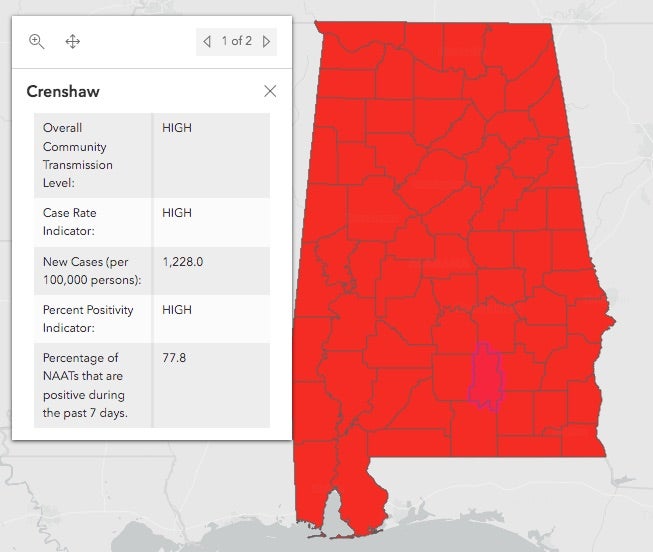Omicron runs rampant across Alabama
Published 5:40 pm Friday, January 7, 2022
The state of Alabama is colored red and it isn’t for Christmas. The Alabama Department of Public Health lists the entire state as a red zone, meaning the COVID variants are spreading rapidly and easily throughout the state.
Crenshaw County is listed at 2,228 confirmed COVID cases per 100,000.
Neighboring counties are not fairing much better. Montgomery County is listed as having 1,170.3 new cases, Butler County is at 784.5
“No doubt, we are beginning to see the new Omicron variant impact our County,” Elliot Jones, Crenshaw County EMA director said. “In the first five days of the new year, we have had 142 positive cases. That is almost 70 percent of the total cases for November and December combined.”
Jones said it isn’t all bad news, but not all good news either.
“The bad news is that this is just the start of this variant making its way through our area. I think that we will not hit our spike until late January if this variant holds here as it has done so in other areas. The infection rate of the Omicron variant has far surpassed all variants to date. It has pretty much has spread like wildfire in comparison to the Delta.
The good news is that this variant is indeed causing symptoms not much worse than that of a common cold or mild flu. We have only had a couple of people that needed hospitalization, and neither of them as of now has been considered critical.”
Jones provided the following data on a study performed in South Africa to compare the impact of Delta versus Omicron in that region.
“This is one of the first areas infected with the Omicron variant. The following is the findings of that study,” Jones said.
Hospitalizations that required oxygen therapy:
DELTA: 74%
OMICRON: 17%
Median hospitalization days
DELTA: 8
OMICRON: 3
Death Rate:
DELTA: 29%
OMICRON: 2%
“If we take proper precautions, we have an opportunity to make our way through what is going to be the highest infection variant with minimal risk to life and health. Please remember that 97% of all individuals who fall victim to death or critical illness are unvaccinated. My household has taken the vaccination, my children and their households have taken the vaccination, and my parents have taken the vaccination. If I felt any danger in taking the vaccination for this virus, I promise I would not have recommended it to my loved ones,” Jones said.
“If we all will continue to wash our hands, practice social distancing, and take our vaccination, we very possibly could shortly see an end to this pandemic that has thrown us off course.”
Jones said to contact him if he can be of any help.
“Please feel free to contact us via our social media, our office (334-335-4538), or you can reach me on my cell day or night at 334-508-2434.”
The Omicron variant was first confirmed in the state in early December.
“We know that this virus is highly infectious and moves quickly throughout the world,” Dr. Scott Harris, state health officer, said. “Alabamians know what to do to keep each other safe now—get the vaccine, get tested, wear a mask indoors and get a booster. Together, we can fight this virus and help keep our residents safe.”
Health officials are urging the public to get vaccinated and get boosters if eligible. Masks are still encouraged when indoors or in public settings as well as staying 6 feet away from others.
The Department of Health says to get tested if you are having symptoms and stay home if you are sick.
The U.S. Food and Drug Administration (FDA) has approved emergency use to Pfizer for Paxlovid, an oral antiviral drug, to treat COVID.
According to data, the drug is 88 percent effective in reducing the number of hospitalizations and deaths of those infected with the virus.
The drug is by prescription only and is in limited quantities. Alabama should receive 780 patient courses by the first week in January. The U.S. Department of Health and Human Services Office of the Assistant Secretary for Preparedness and Response will oversee the allocation of the drug to state and territorial health departments and select Health Resources and Services Administration (HRSA)- funded health clinics.
The production of Paxlovid is set to ramp up significantly in the coming months according to the Alabama Department of Health.
The Center of Disease Control and Prevention (CDC) recently shortened the recommended isolation and quarantine time for people with COVID-19 to just five days.
The CDC said that if a person is asymptomatic, they can wear a mask and be around other people.
The reason for the change in time comes from evidence that most transmissions occur early on in the illness, usually one or two days before symptoms appear and two to three days after.
Infected individuals who cannot follow the recommended masking, such as children, should still remain in isolation for 10 days.






